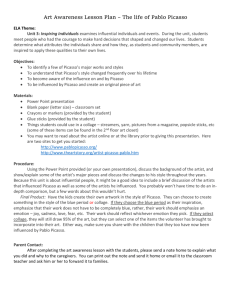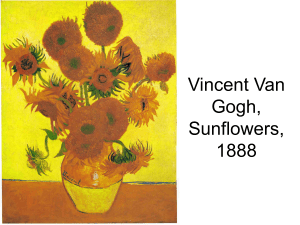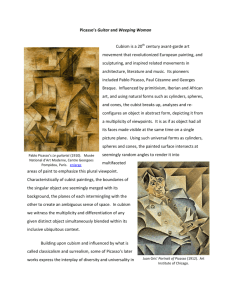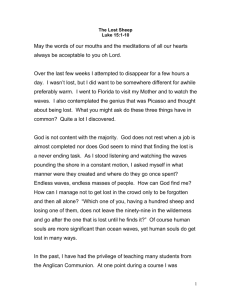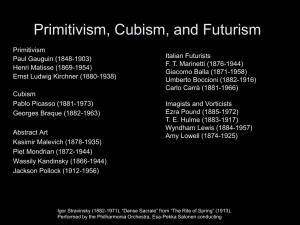Welcome to The Boy Who Bit Picasso resource
advertisement
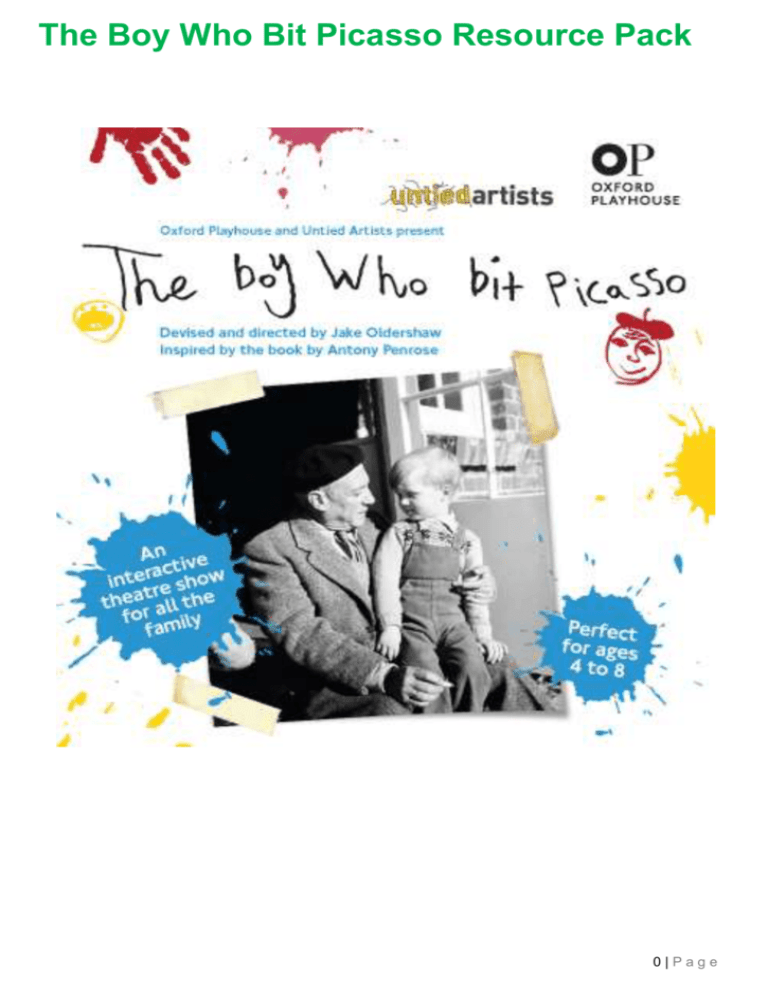
The Boy Who Bit Picasso Resource Pack 0|Page The Boy Who Bit Picasso Resource Pack Introduction Welcome to The Boy Who Bit Picasso resource pack. The play will be performed in the Burton Taylor Studio at Oxford Playhouse from Saturday 28 March to Thursday 2 April 2015 for children aged 4 to 8 years and their families. This resource pack offers craft, art and drama activities which can be used at home or in the classroom before or after your visit to the theatre, and can link to learning across the curriculum. The activities will allow the children to explore their own ideas using different materials and objects, as well as acquiring numeracy and language skills, and knowledge of history and art. The Boy Who Bit Picasso is also about freedom and connection; what it is to feel free to create and express yourself in many different ways using different materials; that different objects and subjects can be combined to express your ideas more fully; the activities will give children the chance to explore these feelings and thoughts within a safe structure. Working creatively through art and drama activities gives children the chance to explore things that matter to them within a fictional context, draw on their prior knowledge and apply it to new situations, develop language as they give expression to new understandings and develop emotional intelligence and critical thinking as they see things from different perspectives. A note for adults – through the pack you’ll notice some footnotes. They link to a resources list at the end of this pack. All the activities should be supervised by an adult. 1|Page The Boy Who Bit Picasso Resource Pack About the Show The Boy Who Bit Picasso is an interactive theatre show for children aged 4 to 8 and their families. Inspired by a true-life story, recorded by Antony Penrose in his book The Boy Who Bit Picasso, the show is about a boy called Tony and the friendship that develops between him and one of the world’s great artists, Pablo Picasso. We first meet Tony at school, during a maths lesson, and he isn’t having much fun and, like many of us, he escapes through a daydream. Later at his family’s farm an exciting visit from Picasso cheers everyone up. Unfortunately the fun can’t last and Picasso has to go home to France. That night Tony dreams about Picasso and William, the bull that lives on the Penrose’s farm, and the next morning Tony and his mum decide to visit Picasso in France. At Picasso’s curious and entertaining home in the south of France everyone is an artist and the audience play and create pictures with Tony and Picasso. But they can’t stay forever and Tony, his mum and the audience return to England. Tony goes to his new school but he has something to treasure from his time with Picasso, as do all the children in the audience. The show itself is interactive, with opportunities for children to be involved in art and craft activities. The work produced by the children in the audience during the show will be photographed and you will be able to view them at flickr.com/photo/untiedartists. We would like it if you took photographs of the work you create at home or in the classroom in response to the show or in using this resource pack and sent them to us in one of the following ways: Tweet @jakeuntied and @OxfordPlayhouse with the hashtag #TheBoyWhoBitPicasso Send photos via facebook.com/theuntiedartists Email jake@untiedartists.co.uk 2|Page The Boy Who Bit Picasso Resource Pack Meet my friend Tony Hello I’m William the bull, you’ll meet me in the show if you haven’t watched it yet. If you’re wondering who that is in the picture, it’s not me, it’s my friend Tony. Anthony Penrose is an energetic boy who lives at Farley Farm in Sussex with his mother, Lee Miller and his father, Roland Penrose. I was very happy when the Penrose’s moved to the farm in 1949 because they’re very kind to me and Anthony told me straight away that he would be my new friend. Anthony, who prefers to be called Tony, enjoys life on the farm as there is always something fun to do, whether it’s digging up the field, feeding us animals or helping his father to create a collage, Tony is not a boy who likes to keep still! He also likes talking and tells me lots of things, like what his mother cooked for dinner, about all the artists that visit the house; Roberto Matta, Joan Miro and Man Ray (to name a few) and about school. I do love to learn about things, Tony teaches me everything he knows. We talk about history and learning other languages. Tony wants to learn French and Spanish so that he can speak to Pablo Picasso, one of the artists that visited the farm. I like maths but Tony doesn’t always remember what the teacher has said, he usually gets told off for day-dreaming. If you’ve seen the show you’ll know who Tony’s favourite visitor is, do you remember? If you haven’t seen the show I’ll tell you, it’s the artist Pablo Picasso. I like Picasso because he likes bulls and he drew and painted bulls in lots of different pictures. In 1950 Picasso visited Tony and me, and his mother and father at Farley Farm. If you haven’t seen the show then Tony has extended the invitation to you, he told me to tell you that he really hopes you can come to the show and meet Picasso, we’ll have lots of fun playing and making things. If you’ve already seen the show then Tony and me hope you had lots of fun! 3|Page The Boy Who Bit Picasso Resource Pack Pablo Picasso Picasso was born in Malaga, Spain, on the 25th October 1881. Like Tony’s father Picasso’s father was an artist and was able to teach and support Picasso with his studies. Picasso was fortunate to attend Art School in La Caruna, Barcelona and Madrid but like Tony, Picasso didn’t like Art School and quit. He begain to visit regularly and eventually moved to Paris, in France. Picasso later moved to the south of France and spent the rest of his life there, that’s why he could speak French and Spanish. Even though Picasso grew older I think he was always a child in his heart, he is well known for the things he said as well as the things he made. “Every child is an artist. The problem is how to remain an artist once he grows up.” Picasso knew he was an artist from a very early age because his first word was “piz” which is short for lapiz the Spanish word for pencil. Tony taught me that the French word for pencil is ‘crayon’, that isn’t too hard to remember! Tony really likes birds so we decided to find out the names of his favourite birds in Spanish and French. English Spanish French Albatross los albatross les albatros Dove paloma la colombe Flamingo el pájaro raro le flamant Pelican el pelícano le pelican Penguin el pingüino le manchot Toucan el tocán le toucan Some words are similar but some words are very confusing, like Picasso’s full name: Pablo Diego José Francisco de Paula Juan Nepomuceno María de los Remedios Cipriano de la Santísima Trinidad Martyr Patricio Clito Ruíz y Picasso 4|Page The Boy Who Bit Picasso Resource Pack Wow! I have to take a really big breath before I can say all of his names in one go. Tony’s mother told us that Picasso finished his first painting Le Picador 1 in 1890, when he was 9 years old. It is a picture of a picador (a bullfighter) riding his horse in a bullring. Picasso painted other pictures with horses, and bulls, and in different styles. I like this because you can see different things about horses depending on the style. Not everyone understood or liked Picasso’s work because he was always exploring new ways to draw, paint and make art. I like that he expressed what you feel and see in your imagination, not just what you can see in the real world. When Picasso visited the farm he painted a picture in the visitors’ book 2 of grasshopper bulls. I like this drawing of the bulls dressed up as grasshoppers, I’d be very happy if I had wings and could fly. If grasshopper bulls existed do you think they would be called bull-hoppers or grassulls? In France Picasso had a pet goat called Esmerelda. If there were other animals on the farm that were a mixture of two animals I would like to see a goat mixed with a toucan, a goatan or would it be a toucoat? I asked Tony to draw a picture of how it might look… 5|Page The Boy Who Bit Picasso Resource Pack Tony decided it would be fun to make a collage, now I have a goatan and a toucoat! Tony’s father, Roland Penrose, was like Picasso because he didn’t just make one type of art, he liked to paint, make sculptures and create collages 3. Collage comes from the French language and means ‘to glue’, you collect different pictures, cut or tear them up and stick them together to make a new picture. Tony’s father used postcards to make his collages, Tony used pictures from magazines to make a collage field for my goatan and toucoat to run around and play. 6|Page The Boy Who Bit Picasso Resource Pack If you had a pet that was a mixture of two animals what would they be? Draw a picture of your animal below. Ask your parents or teacher to help you make a collage like Tony. 7|Page The Boy Who Bit Picasso Resource Pack Picasso’s Art Works of art are categorized into different genres (types or styles) and artists usually choose one or two genres to work in for their whole life. Picasso worked in many different styles and they are usually described in the following order: Realism The art schools that Picasso attended were strict and formal in their teaching, and taught students to create drawings and paintings that depicted truthful representations of life. Although as a teenager Picasso painted realistic portraits and landscapes 4 he was more interested in depicting how the world feels. Blue Period When Picasso moved to France with his friend Carlos Casagemas moved with him. Unfortunately Carlos died in 1901 and Picasso became very sad and lonely. From 1901 to 1904 Picasso painted scenes of poor people who were suffering and upset and he only used shades of blue and green paint. 5 Rose Period In 1905 Picasso started to feel better and he also fell in love. He began to use pink and red paint. Emotion was still very important in his work and he changed and repainted his work to give it depth and create colours that would show the mood he was trying to represent. 6 Cubism From 1906 Picasso, and another artist Georges Braque, began experimenting by breaking images down into geometric shapes and depicting their subjects from more than one point of view at the same time. This style is similar to collage because a picture is created by deconstructing and reassembling an object. Lots of people were shocked by this abstract way of creating art because they had never seen anything like it before. 7 8|Page The Boy Who Bit Picasso Resource Pack Surrealism During the late 1920s Picasso’s Cubist style developed alongside and into a new movement called Surrealism, which explored the expression of thoughts, dreams and the subconscious. Picasso also designed some of the front covers of the French Surrealist journal Minotaure. Picasso’s most well-known surrealist painting is Guernica 8. Guernica and the Spanish Civil War The following paragraph gives a brief explanation of the Spanish Civil War. You may not wish to explore this subject with your child or class. Picasso created Guernica as a response to the bombing of the town of Guernica in Spain in April 1937. Picasso depicts the anguish of the innocent townspeople, only using the colours blue, black and white to intensify the drama of the painting. The painting is mural size (3.5m x 7.8m) and amongst the suffering figures there is also a horse and a bull. Guernica became a powerful anti-war symbol and has been displayed in many countries around the world. The townspeople in Guernica were known to oppose General Fransico Franco and to punish their resistance to him Franco allowed Hitler to bomb the town. Before World War II Spanish society had become polarized between the Nationalists (mainly military, Roman Catholics, landowners and businessmen) and the Republicans (those belonging to the urban and agricultural working class and educated middle class), although there were many small groups covering the political spectrum in between. Franco trained as a soldier and eventually became a General and in 1934 he suppressed protests made by miners in northern Spain. From 1936 to 1939 he led the Nationalist forces against and eventually overthrew the democratic Spanish Republic. This became known as the Spanish Civil War. It ended with Franco’s victory, ruling Spain as a dictator. Franco remained head of the Spanish government until 1973 and Head of State until he died in 1975. Picasso said that he would not visit or live in Spain while France remained in power which unfortunately meant that he never visited his country of birth after 1936. 9|Page The Boy Who Bit Picasso Resource Pack Throughout his life until he died in 1973 Picasso created work in many different styles and media. As well as drawing and painting, he experimented with sculpture, ceramics and printmaking. In 1917 he even designed the set and costume for a ballet, Parade. Tony and I think that it must have been fun for Picasso to work in many different styles, imagine eating the same food for breakfast, lunch and dinner every day for your whole life! Although if you live at Farley Farm you never eat the same thing twice and the food looks like art! If you have watched the show we hope you had fun and are inspired to draw, paint, create and take photographs, art is fun. If you haven’t watched the show we look forward to meeting you. Tony has drawn a picture of us playing in the field so that you will remember us. Please remember to send photographs of your work to us: Tweet @jakeuntied and @OxfordPlayhouse with the hashtag #TheBoyWhoBitPicasso Send photos via facebook.com/theuntiedartists 10 | P a g e The Boy Who Bit Picasso Resource Pack Email jake@untiedartists.co.uk Art Activities The following activities should be supervised and are suitable for children aged 4 to 10 years. Emotions You will need A4 or A3 pieces of plain paper, pencils and paint or felt-tip pens. Discuss emotions with your child or your class; what emotions are there and how are they expressed? For example, sadness can be expressed by tears and happiness with a smile. Talk about how some forms of expression can represent more than one emotion, i.e. tears of sadness and tears of happiness. Ask your child or the class what emotions feel like? Do they feel nice or horrible? Ask your child or the class to choose an emotion and draw or paint what they think the emotion looks like and to choose a colour or colours for that emotion. Discuss what colours are associated with different emotions. Colour your character You will need a large piece of plain paper, you can use the back of a roll of wallpaper if you don’t have a paper roll, and paint or felt-tip pens. Lie down on the piece of paper and ask your mum or dad to draw around you or you can draw a friend or classmate. If you don’t have any large pieces of paper use the body outline on the next page. Draw the details of the person’s face, hands and feet, and clothes. If it is a picture of you, decide what mood you are in and pick no more than three colours to represent your mood. If it is a picture of someone in your family or a friend or classmate chose no more than three colours that best represent their personality, i.e. orange because they are always happy or purple because they are very serious! Cube your character Take a photograph of a family member or a friend in profile (the side of their face) or ask someone to take a photograph of you in profile. Print the picture and then put a 11 | P a g e The Boy Who Bit Picasso Resource Pack blank piece of paper over the picture and trace the outline of the face. Draw or paint features so that you can see all sides of the face at the same time 9. 12 | P a g e The Boy Who Bit Picasso Resource Pack 13 | P a g e The Boy Who Bit Picasso Resource Pack Use the links at the end of the pack to find examples of portraits drawn or painted by Picasso, or you can use books from the school or local library. Below is a list of questions you can use to discuss the portraits. Find portraits by other artists and discuss the different styles, and their similarities and differences. 1. Is each a portrait of just a head/face or part or full body? 2. Are they colour portraits or just black and white, or just shades of one colour? 3. Is each portrait a realistic representation of the subject? 4. Is the person in the portrait relaxed or is it a formal picture? 5. Is the person in the portrait displaying an emotion? How do you know what the emotion is? 6. Are any of the persons features distorted? How does this affect what you see and how you feel? 7. What materials has the artist used? 8. What do you like about each portrait? 14 | P a g e The Boy Who Bit Picasso Resource Pack Language Activities Tony’s Farmyard Using the pictures can you name the animals on Tony’s farm? Can you remember which animal was Picasso’s pet Esmeralda? English Spanish French el toro le taureau el pollo le poulet la vaca/la hembra la vache el burro le baudet la chevre la cabra el cerdo le cochon la cabra el toro le poulet le cochon el burro 15 | P a g e The Boy Who Bit Picasso Resource Pack Picasso’s Palette To help Picasso learn English write the name of each colour next to the Spanish and French words. English Spanish French negro noir azul bleu marrón brun verde vert gris gris color naranja orange púrpura pourpre tinto rouge blanco blanc amarillo jaune 16 | P a g e The Boy Who Bit Picasso Resource Pack Numeracy Activities Multiplication Grid Use different colours to fill in each column or row to highlight the multiples of each number. 1 2 3 4 5 6 7 8 9 10 2 4 6 8 10 12 14 16 18 20 3 6 9 12 15 18 21 24 27 30 4 8 12 16 20 24 28 32 36 40 5 10 15 20 25 30 35 40 45 50 6 12 18 24 30 36 42 48 54 60 7 14 21 28 35 42 49 56 63 70 8 16 24 32 40 48 56 64 72 80 9 18 27 36 45 54 63 72 81 90 10 20 30 40 50 60 70 80 90 100 Adding Aeroplane Journey from Calais to Château de Vauvenargues by flying over: Eastbourne, the Channel, Rouen, Paris, Lyon and Marseille, adding as you go. 17 | P a g e The Boy Who Bit Picasso Resource Pack Numeracy and Creative Writing In the show Tony finds music and singing help him with his homework. Ask your child or class to try writing a simple rhyme to help them with their learning. You can split your class in to small groups to create a rhyme about odd and even numbers, or times tables, or adding and subtraction. Here are some lines from Tony’s song to help you. Seven times three is twenty-one I’m sort of having fun Eight times three is twenty-four I’ve never got this far before Nine times three is twenty-seven Bertie Wilson can’t do that one, and he’s eleven So do this next one I’ll beat Bertie, ‘cos ten times three is thirty! Creative Writing Daydream Adventure Ask your child or class to think about going on an adventure when they should be at school. Ask them to imagine they are sat by an open window in their classroom and they are able to climb out without the teacher noticing. Ask them to tell you or write a short story about what happens next. One Word Story You can play this game with two or more people. Sit opposite your child or ask your class to sit in a circle. Explain that you are going to create a story together by taking it in turn to one word so together they create the sentences that make up the story. You may want to include the rule that you must say full-stop if you think it is the end of the sentence. The sentences must make sense so the children will need to listen very carefully to each word to remember what is happening in the story and to choose a word that builds the sentence and story. You may need to pause the story 18 | P a g e The Boy Who Bit Picasso Resource Pack to remind the children what has happened or to encourage them to find an ending for their story. The story must have a clear beginning, middle and ending. Numeracy – Multiplication Grid Answer 1 2 3 4 5 6 7 8 9 2 4 6 8 10 12 14 16 18 20 3 6 9 12 15 18 21 24 27 30 4 8 12 16 20 24 28 32 36 40 5 10 15 20 25 30 35 40 45 50 6 12 18 24 30 36 42 48 54 60 7 14 21 28 35 42 49 56 63 70 8 16 24 32 40 48 56 64 72 80 9 18 27 36 45 54 63 72 81 90 10 20 30 40 50 60 70 80 90 10 100 19 | P a g e The Boy Who Bit Picasso Resource Pack On-line references and resources Links to illustrations of Picasso’s work: 1 http://www.pablopicasso.org/picasso-facts.jsp - Pablo’s first drawing 2 http://www.telegraph.co.uk/culture/culturevideo/cultureminute/4516615/Le e-Miller-and-Friends.html - Video featuring Picasso’s Grasshopper Bulls 3 http://www.rolandpenrose.co.uk/ - Roland Penrose/Works/Collage 4 https://www.nga.gov/exhibitions/picbro.shtm - Study of a Torso 5 http://www.pablopicasso.org/old-guitarist.jsp - The Old Guitarist 6 https://www.nga.gov/collection/gallery/20centpa/20centpa-46665.html Family of Saltimbanques 7 http://www.pablopicasso.org/three-musicians.jsp - Three Musicians 8 http://www.pablopicasso.org/guernica.jsp - Guernica 9 https://www.nationalgalleries.org/collection/artists-a-z/p/artist/pablopicasso/object/lee-miller-gml-331 - Lee Miller a) Picassohead – a digital tool that provides famous features drawn by Picasso that you can use to create your own masterpiece! http://www.picassohead.com/about.html Glossary Abstract Expression of general ideas and emotions using colours and lines that does not attempt to create a realistic picture. Cubism Representing objects by emphasising its geometric 20 | P a g e The Boy Who Bit Picasso Resource Pack shapes and presenting the object from more than one angle simultaneously. E;g. George Braque and Paul Cezanne. Dictator A person who holds absolute authority or power. Fascism A system of government led by a dictator who has complete control over the lives of the people in their society, nation or country. The power is usually gained by violent of military force. History Painting The culmination of skills taught through a rigorous system. Paintings were large and the subject was usually a classical, mythological, literary or religious event. Nationalism A feeling of loyalty and pride in a person’s own country. Or a strong belief or political ideology that nation you live in interests are of primary importance Realism Accurately depicted scenes from everyday life. E.g. William Dyce and Gustave Courbet. Surrealism Expression of the dream world of the subconscious, often strange and fantastical. E.g. Joan Miro and Roberto Matta. 21 | P a g e

